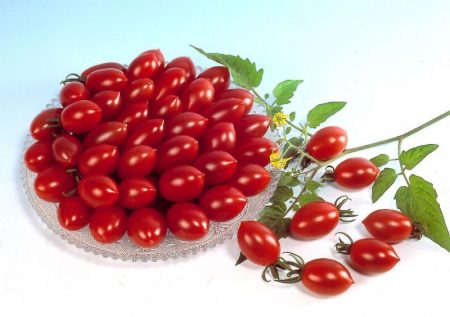 There are tomato bushes and most varieties are represented by them. Medium, tall, even low. People grow such bushes regularly. But the tomato tree Octopus looks very different. It is also necessary to grow it in other conditions.
There are tomato bushes and most varieties are represented by them. Medium, tall, even low. People grow such bushes regularly. But the tomato tree Octopus looks very different. It is also necessary to grow it in other conditions.
Grade characteristics
Those who want to grow a real tomato tree Octopus f1 must first get hydroponic. In open ground, in a garden or a simple greenhouse, it does not take root. Hydroponics will ensure complete safety of the tree from various pests, diseases that often attack trees under 1.5 years old. Yes, the cultivation of such a miracle is a real, tall and sprawling tomato tree that gives dozens of small, neat, bright red fruits a lot of work.
All comers need to carefully study the care requirements for this. variety of tomatofeatures of the location of the tree, view photos and preferably personal communication with experienced gardeners, gardeners. Outwardly, tomato trees look like fantastic plants, especially mature ones. Tall, sprawling, tomatoes look more like red grapes.
If we talk about the variety of Octopus Cherry, the fruits are small, neat, red shades. Genetically, in the bushes, congestion is determined due to rapid growth with subsequent branching. Therefore, the tree needs constant care, nutrition, and good lighting. Otherwise, octopus tomatoes will not grow into a full, large tree.
What is required?
Trees cannot be grown in open ground, because they need a place heated all year round, alas, it is unlikely that he will endure the winter without protection. Fits spacious, tall polycarbonate greenhouse with heating, where it’s warm, not hot.
Obligatory access to 5-6 hours of full sunlight, otherwise the tomatoes will remain immature.
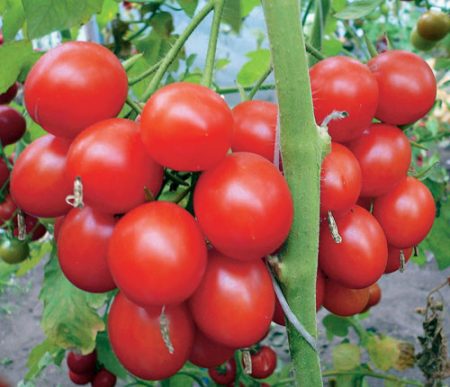
Soil with its Ph level 5.5, maximum 6.8, fertile, well-drained, still rich in organic matter.
Attentive attitude to watering, many summer residents caring for such a miracle, note the uneven absorption of liquid by the tree, which then causes various problems, for example, leaves fall or the trunk cracks, begins to rot.
Those who have been practicing the cultivation of Octopus for a long time and planted it are still advised to take normal small boxes, not small portable containers, for seeds. First, choose a place in your garden where the sun warms more. Then prepare the soil, loosen it, make compost, organic fertilizers. Here is the place of the future nursery. To warm the soil better, cover it with ordinary polyethylene for 2-3 days.
Octopus cream f1 is considered more resistant to unpleasant decay.
Tomato seeds germinate somewhere in the 7-14 day, if the temperature in the open ground holds 21 degrees. See that the soil remains moist, but excess moisture often leads to the rapid onset of various diseases. Be careful, protect sprouts from unexpected frosts, also cold winds, drafts, inspect seedlings more often, revealing the beginnings of diseases in the early stages, since any infection can easily destroy immature plants.
Indeed, Octopus tomatoes are unique. By the type of bushes, rather a whole tree, by the arrangement of fruits, by their shape. Tomatoes are beautiful, oval, and their tree is just fine.
Care Features
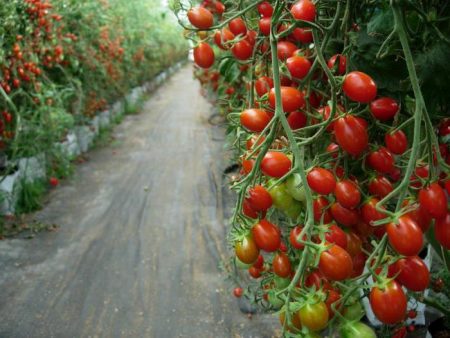 Seedlings require abundant watering the first days, while the growing season lasts (approximately at a depth of 5 cm, this is every week until summer). Cover the soil with a compost layer, constantly mulch all 4 weeks as the seedlings are planted. Plants must be well rooted.Of course, the cultivation of any plant requires care, attention from the owner, not in vain because the labor of the gardener is called “labor” and the harvest is “fruits of labor”.
Seedlings require abundant watering the first days, while the growing season lasts (approximately at a depth of 5 cm, this is every week until summer). Cover the soil with a compost layer, constantly mulch all 4 weeks as the seedlings are planted. Plants must be well rooted.Of course, the cultivation of any plant requires care, attention from the owner, not in vain because the labor of the gardener is called “labor” and the harvest is “fruits of labor”.
If drought is expected, collect a few flat stones and place them close to each sprout. Stones serve as a natural storage of water, preventing its evaporation into the atmosphere. Remember, under a long lying stone, the soil is always slightly moist. A similar measure will bring large, ripe fruits and an excellent harvest.
Is a tomato tree a myth?
Who first examined tomato Octopus cream in various photographs or videos, often asked, is this a myth? A large, tall and sprawling tree adorns the greenhouse, creating the complete impression of unreality. One can see several thin stems extending from below, and everything else, including fruits, branches, above, supported by a special metal construction. Is it possible to grow such beauty? Moreover, ripe tomatoes are clearly visible from below, formed by clusters, just like grapes.
Reviews of most gardeners who practice growing tomato trees respond positively. Reality. The wonders of selection. Of course, to see such a miracle in your area, you need to make every effort.
Growing problems
Decay
Rot is considered one of the most common and unpleasant problems during the cultivation and ripening of tomatoes. It spreads more often in wet, humid weather, then quickly spreads throughout the plant, "eats" it. The plant begins to die, the fruits are damaged. Symptoms are quite noticeable, rot is easy to identify by characteristic brown spots. More often, rot appears in tomatoes growing on the street, especially in a greenhouse. For prevention, carefully spray your tree with a special solution by the beginning of summer. Then inspect periodically.
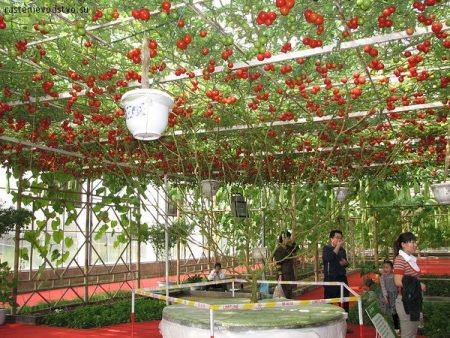
Most problems come from irregular, irregular watering. If dark spots are visible at the base of the fruits, then the plant was grown indoors and felt a lack of water. The solution to the problem is regular, uniform watering, in the direction under the root. But the amount of water also needs to be monitored. Excess threatens with negative consequences.
Pests and insects
They do not miss any kind of vegetables or fruits. Insects not only harm the leaves, fruits, but often serve as carriers of various infections. Therefore, use insecticides as soon as you notice the slightest signs of pests. It is necessary to spray and simply, for prevention. The most popular of the pests are caterpillars, which are attracted by succulent leaves, tasty fruits. The fight against them is often long and rather exhausting, especially when the tree is already large.
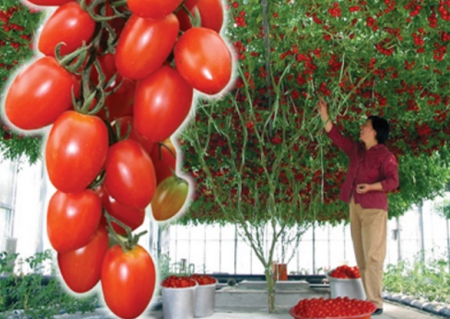
Recommended:Tomatoes for the Rostov region, seeds of the best grades
Aphids also have problems. To get rid of it, try to sprinkle the affected leaves with just cold water (often this is enough). You can make a soap mixture from soap with cayenne pepper plus water. Pretty effective and unpleasant insect repellent. Treat the mixture with leaves, twigs manually.
Fighting caterpillars comes down to gathering. You can plant a dill next to the tomato tree of your neighbor to prevent re-emergence. And already collected everything neatly. Unpleasant of course, but an experienced gardener is not afraid of insects.
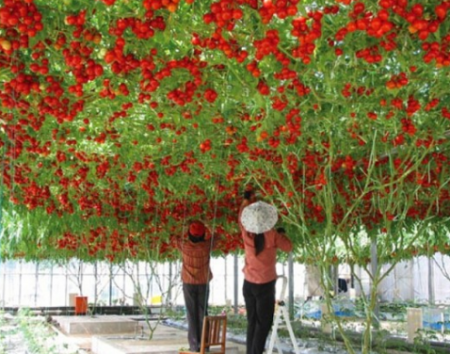
Leaves
It happens that leaves turn yellow on the bush, and summer is in the yard. If one leaf remains yellow fearlessly, but more often yellowness spreads rapidly, like an infection. Carefully inspect all affected leaves. If yellowness began with old leaves and then spread, then perhaps this is not a virus eating them, but a manifestation of a lack of magnesium. The problem is not serious, plant resistance and health are not harmful.To quickly eliminate it, take special fertilizers, where there is magnesium.
Leaves twist - this may be a natural mechanism, the reaction of a plant to a low temperature or the appearance of aphids. If the matter is an insect, then usually the aphid inside a twisted cocoon has gathered a leaf around itself, twists it and eats it slowly. It happens that aphids are not nearby, but the leaves themselves look damaged, the "work" of the pest is visible.
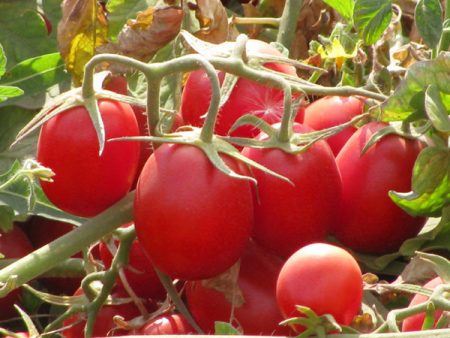
When strange mosaic patterns appear on the leaves, sometimes stripes or bloating areas, then tomatoes may be affected by the virus. Then remove all damaged leaves, they can no longer be restored. When removing, proceed carefully, taking care not to touch the intact leaves, fruits. After the “operation”, thoroughly disinfect the instruments, and wash your hands with hot, soapy water, otherwise you will become an involuntary carrier of infection. Alas, plants can also get sick, they even have cancer.
Tree diseases
The blogs of various summer residents who keep the greenhouses have descriptions of diseases and other problems that they have sometimes encountered. The experience described helps others. Members of the forum keep in touch regularly, this includes access to useful tips, the opportunity to discuss the harvest, especially the feeding and care. For example, in addition to harmful insects, strange manifestations on the surface of leaves, there are other diseases of tomatoes. The most terrible, real scourge of gardeners is late blight.
Himself late blight - a fungal disease, it often affects the fruit. Its manifestation is immediately visible - brown leaves are discernible on the leaves or stems of the plant.
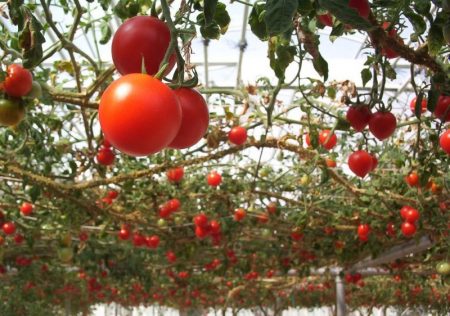
There are special insecticides against the disease, preventive treatment of the plant, regular inspections are needed.
Harvesting
When about to harvest from greenhouse tomatoes? Of course, as they mature. But summer residents have a little trick. To get more ripe fruits from the bush, start picking the fruits as soon as they begin to blush (or turn brown). It seems to be immature, but if they are simply left on the windowsill open to the Sun for 1.5-2 weeks, the tomatoes will ripen easily. To taste, appearance will become similar to their comrades ripened on a bush.
Usually a sign of ripeness is a bright color, hardness of the fetus. The color of the octopus gradually changes from ordinary green to light pink, sometimes yellow. Other exact signs differ in different varieties, but most are determined precisely by the hardness of the fetus and the brightness of the color (no matter which). It is safer to store the collected tomatoes in room, normal temperature and indoors. Low temperatures will easily cause spoilage.
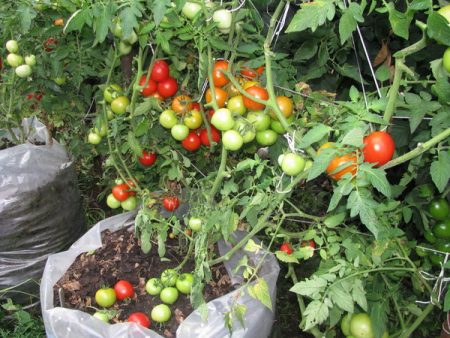
Recommended:Tomato Beefsteak: characteristics of the variety, reviews
There is no need for Sprut to pick off stepsons, also do not touch the side shoots, because a large, sprawling tree is planned. But so that it grows tall, strong, feed with mineral fertilizing with ammonium nitrate, also potassium nitrate or simple superphosphate. The plant needs copper sulfate, zinc with magnesium, and also boric acid. Ready nutrient solution needs to be fed somewhere once in 5-7 days.




 Low-growing tomatoes, without pinching: 5 of the most delicious varieties
Low-growing tomatoes, without pinching: 5 of the most delicious varieties Why tomato seedlings grow poorly
Why tomato seedlings grow poorly We grow a tomato in a shell
We grow a tomato in a shell Growing tomatoes without watering according to the method of Kazarin
Growing tomatoes without watering according to the method of Kazarin